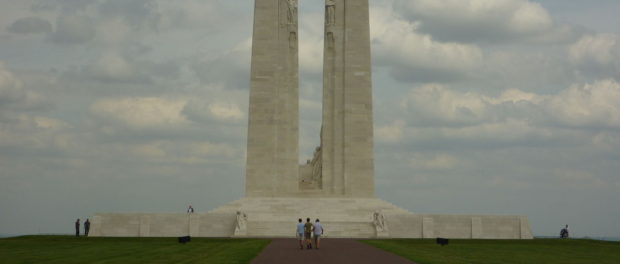Book of the Month Club: Vimy: The Battle and the Legend by Tim Cook
Stories of the Canadian participation in foreign wars go back to the days when parts of Canada were part of French territory, but it is the contemporary story of the Canadians at World War I, at Vimy Ridge in particular, that still manages to capture the imagination of subsequent generations. The Vimy Memorial in France, whose street address is fittingly the “Chemin des Canadiens”, only adds to the mystique and the tribute to the four Canadian battalion that participated in the battle.
Canadian participation in the war, that is, including a strictly Canadian battalion or infantry, goes back many years, but the idea of the emergence of Canada as a semi-independent fighting force was a new idea. The Vimy myth started shortly after the fighting ended, quickly supplanting the Second Boer War as the war that would place Canada on the map. This is where Tim Cook’s book comes in: not only a tactical retelling of the Canadian participation within the British Army, it is also how the myth of Vimy started and grew into the source of patriotism it is today.
Before Vimy, Canadians would take part in battles such as the Battle of the Somme and participate in military reconnaissance operations, the latter which was almost a suicide mission involving flying low in order to take aerial photographs of the opponents’ camps and trenches. Political pressures back home encouraged the Canadian-led battalion to fight as a single unit, and while often two or three out of four battalions would fight together, Vimy Ridge was the only location where all four battalions manned and commanded by Canadians would fight side-by-side.
Cook’s book takes the reader through the painstaking planning of the war and how the battle proceeded. As the tour Canadian battalions proceeded against the three German ones, not all things went as planned, down to the very date of attack. It ended with the Canadian’s in control of the ridge, keeping it under Canadian control until the battalion were called elsewhere. It is the aftermath, however, that makes up most of the book and proves the most interesting. In a world where mailing a letter took about three weeks, near of Vimy Ridge and the main offence’s great success of April 9, 1917 was able to make the evening papers of the same day, extolled even by papers that were critical of the war (such as Le Devoir). It did not come without heavy loss, and Borden, the Prime Minister, would decide to break a promise and enforce conscription in Canada, causing riots and even death back in Canada. Or the war’s end, Canada lost over 60 000 people and was millions in debt. It was in this period of an inward-looking, pensive Canada that a legend and a new mentality would form. Bearing witness to its accomplishments and honouring the dead would be a way to bring together a burgeoning nation.
Cook’s writing is peppered with extracts of letters, diaries, and other writings of people who fought and the people] involved in the creation of the Vimy Memorial, myth-makers both known and unknown. Shoe extracts keep the book from becoming pure exposition and aid greatly in capturing the thoughts and feelings of the people in the Vimy story. His analysis of the artistic style and intention of the sculptures for the memorial and interesting discoveries about the commercialism of the Vimy accomplishment (Vimy Ridge canned salmon?) provide an interesting starting point for research about its use in politics and propaganda, both immediately following the war and into World War II and beyond. Cook includes a discussion about French-Canadian involvement and reaction to the war, which I would have liked to see more of, and it is unfortunate that only a few short sections are included to show dissent, past and present, of this important segment of the population.
Cook’s book, just in time for Vimy’s 100th anniversary is a sobering reminder of mythmaking, facts, and spin for uses good and slightly more nefarious. Recommended for your local history and military buffs.






